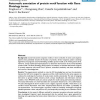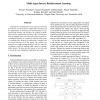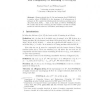2969 search results - page 87 / 594 » Ontology Learning: Where are we |
BMCBI
2004
13 years 10 months ago
2004
Background: Conserved protein sequence motifs are short stretches of amino acid sequence patterns that potentially encode the function of proteins. Several sequence pattern search...
BMCBI
2007
13 years 10 months ago
2007
Background: Incorrectly annotated sequence data are becoming more commonplace as databases increasingly rely on automated techniques for annotation. Hence, there is an urgent need...
COLT
2008
Springer
13 years 11 months ago
2008
Springer
We describe and explore a new perspective on the sample complexity of active learning. In many situations where it was generally believed that active learning does not help, we sh...
ICMLA
2010
13 years 8 months ago
2010
Learning the reward function of an agent by observing its behavior is termed inverse reinforcement learning and has applications in learning from demonstration or apprenticeship l...
ALT
2006
Springer
14 years 7 months ago
2006
Springer
Higman showed that if A is any language then SUBSEQ(A) is regular, where SUBSEQ(A) is the language of all subsequences of strings in A. We consider the following inductive inferenc...



